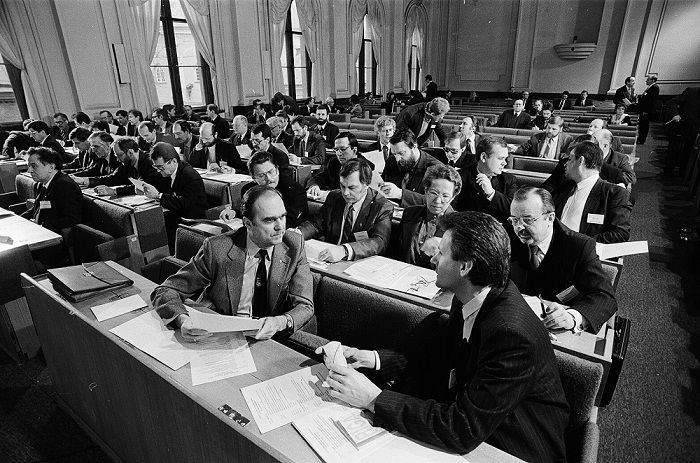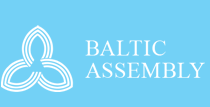Integration into the international community, 1992 - 1995
During this period, both domestic and external factors influenced regional cooperation among the Baltic States and the agenda of the Baltic regional organisations. Various main courses of action crystallised in the cooperation of legislative and executive powers of the Baltic States: 1) strengthening independence and resolving political, social, environmental and economic problems; 2) promoting the return of the Baltic States to the international arena; 3) shaping a model for cooperation among the Baltic States; and 4) improving the security and defence of the Baltic States.
After recovering independence, the Baltic States started the process of joining international organisations. On 5 March 1992, the Baltic States, together with 8 countries in the Baltic Sea region, established the Council of the Baltic Sea States. In 1992, the Baltic States became members of the World Bank, the European Bank for Reconstruction and Development, the International Monetary Fund; they became members of the North Atlantic Cooperation Council, and were eligible for support under the EU PHARE programme. In 1992, the Baltic States, signed Trade and Economic Cooperation Agreements with the European Community. In 1994, Estonia and Latvia each signed a Free Trade Agreement with the European Community, while Lithuania signed such an agreement in January 1995. Estonia and Lithuania were accepted as members of the Council of Europe in May 1993, while Latvia became a member two years later. The Baltic States joined the NATO "Partnership for Peace" programme in 1994, and became associate members of the Western European Union. In 1994, the Baltic States applied for membership of NATO.
Strengthening the independence of the Baltic States and advocating their return to the international arena were the most pressing items on the cooperation agenda. The Baltic States agreed on coordinating foreign aid, creating a common information system, developing a joint strategy in the field of energy supply, harmonising their legislation in various areas, defining borders and border-crossing procedures, improving the effectiveness of customs, as well as cooperation in education, science and culture. The Baltic Assembly provided a framework for sharing opinions and coordinating positions on transforming economic systems of the Baltic States, introducing national currencies, holding elections, etc. Other topical issues were the global image of the Baltic States and the need to disseminate true information about their development.

1st Session of the Baltic Assembly in Riga, 24-26 January 1992
Despite fierce economic competition among the Baltic States, as a result of debates in parliamentary and executive branches, on 13 September 1993 a Free Trade Agreement was signed with the aim to create a single Baltic market. Alongside economic benefits, this Agreement also had other benefits: 1) commitment of the Baltic States to cooperate; 2) accelerated integration into the international community; 3) by signing the Agreement, the Baltic Sates became a more attractive market for foreign investors.
Between 1992 and 1995, the Baltic Assembly provided a platform for lively discussions about a Baltic cooperation model. The Baltic parliamentarians were convinced that adopting the Nordic cooperation model would boost the political and economic development of all three countries. After intense debates, the Treaty on Cooperation among the Governments and Parliaments of Estonia, Lithuania and Latvia was signed on 13 June 1994 in Tallinn. The Treaty provided a legal framework for regional cooperation among the Baltic States in general and for regional organisations of the Baltic States in particular. The Treaty envisaged establishing an institution for cooperation of the executive branches of Estonia, Latvia and Lithuania, namely, the Baltic Council of Ministers. According to the Treaty, cooperation between the Baltic Assembly and the Baltic Council of Ministers was intended to be carried out in the framework of the Baltic Council.
One of the most important items on the Baltic cooperation agenda during this time was the withdrawal of troops of the former USSR from the Baltic States and development of a joint strategy of the Baltic States with regard to the troops of the former USSR deployed in these territories. This issue was addressed in various ways and formats. First, the Baltic States managed to formulate, coordinate and express a common position on this issue. Second, the Baltic States tried to use the diplomacy of meetings in order to directly resolve the existing problems together with political and military representatives of the Russian Federation. Third, the Baltic States sought the support of the international community in resolving this issue. Fourth, the Baltic States managed to include the issue on the withdrawal of Russian troops in the Treaty on Parliamentary Cooperation between the Baltic States and the Nordic Countries. Fifth, regional cooperation of the Baltic States resulted in regular and ongoing national and international dialogue on this issue. Sixth, the presence of the Russian troops in the Baltic States mobilised their parliaments and executive branches to resolve various sectoral issues, such as, streamlining border procedures, developing an energy strategy, and developing communications and infrastructure in the Baltic region.

Withdrawal of the Russian troops, August 1994
Integration into the European Union and NATO appeared on the agenda of the Baltic Assembly and subsequently also on the agenda of the Baltic Council of Ministers. On 31 October 1993, the Baltic Assembly called on NATO to devise accession criteria for the Baltic States. Official discussions on the need for a uniform position and policy of the Baltic States with regard to their integration into the European Union began in 1994, when the Baltic Assembly urged the European Union to accelerate the signing of the European agreements with the Baltic States; the Baltic Assembly agreed on mutual consultations and harmonisation of national legislative acts with the requirements of the European Union.
During this period also first disagreements arose among the Baltic States. The first was a dispute between Latvia and Estonia in 1993 over a fishing area; it was resolved through the mediation of Sweden. The second was a dispute between Latvia and Lithuania over the sea border; that matter has still not been settled. The third was a dispute between Latvia and Lithuania in 1995 over air space; it has been resolved. The fourth was a dispute that escalated in 1994–1995 between Latvia and Estonia concerning the development and solving of problems of the border towns Valka and Valga. The Baltic Assembly discussed these disagreements, and parliamentarians called on the governments of the Baltic States to immediately settle these disputes bilaterally.
The Baltic Assembly played an important role in the integration of the Baltic States into the international arena. On 30 May 1992, it concluded a cooperation agreement with the Nordic Council that strengthened parliamentary cooperation between the Baltic States and the Nordic countries in environmental protection, security policy, education and culture, market economy, agriculture, energy, and infrastructure. This international agreement was extremely important for the Baltic States because it promoted their return to the family of the Northern European countries. The cooperation agreement concluded between the Baltic Assembly and the Benelux Parliament on 18 November 1994 in the Hague was also an important step for the Baltic States because it facilitated their return to European politics. The experience of the Benelux countries helped the Baltic States to better understand the cooperation among the European countries, to transpose the experience of the Benelux countries in cross-border cooperation, foreign affairs and harmonisation of legislative acts.
A major event of this period was also the establishment of the Baltic Assembly Prizes, an idea that was conceived in 1992. On 31 October 1993 in Tallinn, the Baltic Assembly adopted the decision to establish the Baltic Assembly Prizes for Literature, the Arts and Science. The aim of the Prizes is to support outstanding achievements in literature, the arts and science; demonstrate the common interests of the countries in this region in upholding of their national identity and self-esteem; create an opportunity to learn about the achievements of the neighbouring countries; maintain a continuous interest among the people in Estonia, Latvia and Lithuania about developments in the Baltic States; strengthen cooperation among the Baltic States in the fields of literature, the arts and science; encourage more and more people to become interested in the intellectual values and languages of the Baltic nations; raise the level of literature, the arts and science in the Baltic States.
The parliamentary and executive cooperation among the Baltic States was aimed at attracting the attention of the international community to the Baltic region, international integration of the Baltic States, strengthening the independence of the Baltic States and resolving common problems related to environment, economy, education, health care, social sphere and other areas.
© Photos by Uldis Briedis and Uldis Pāže



